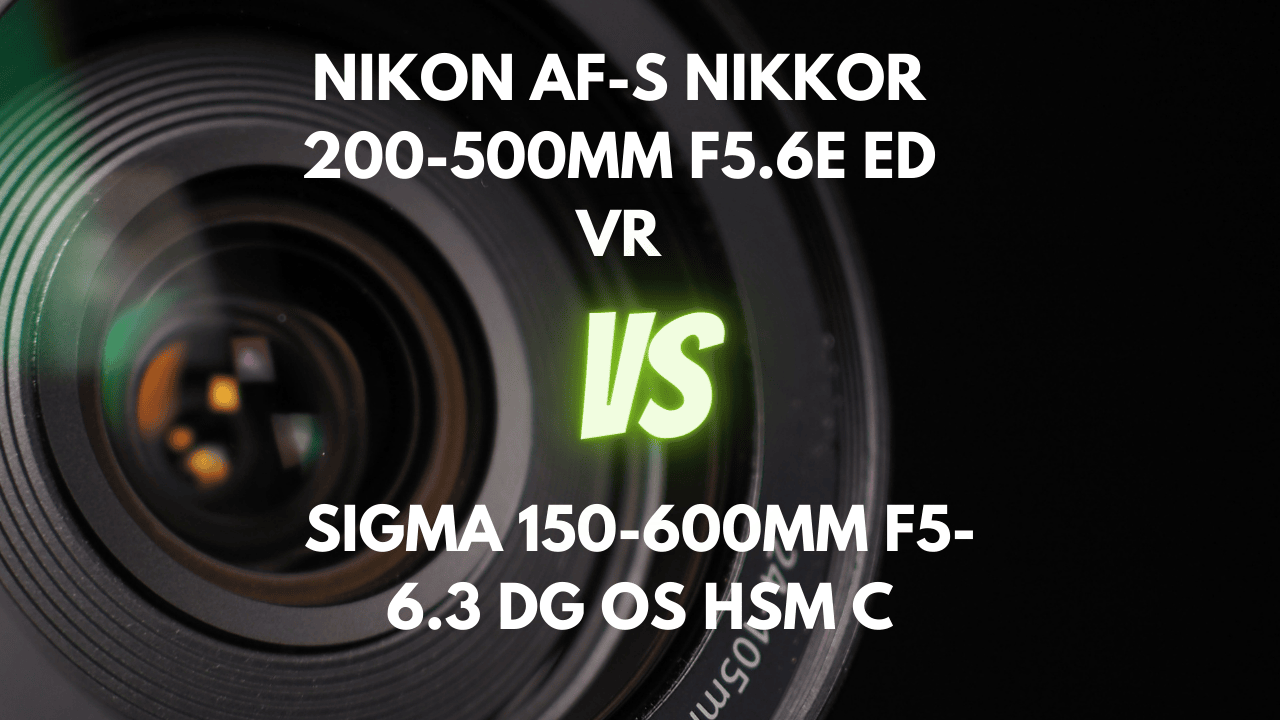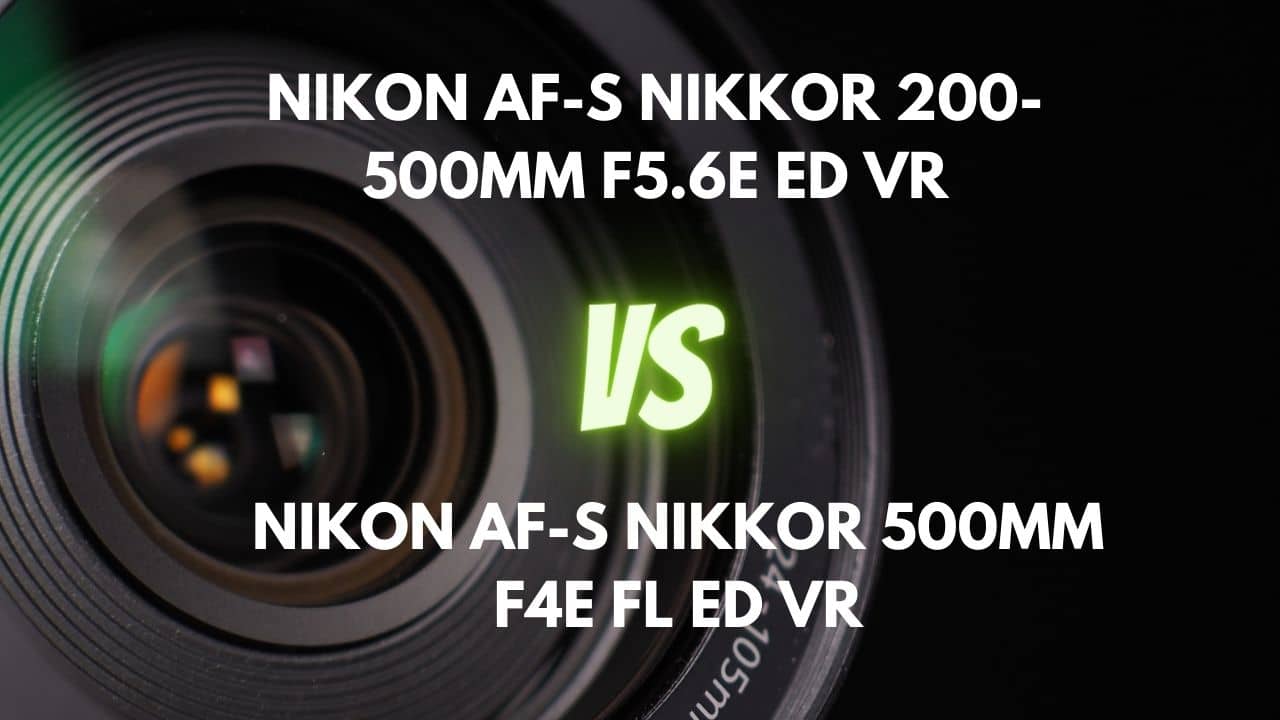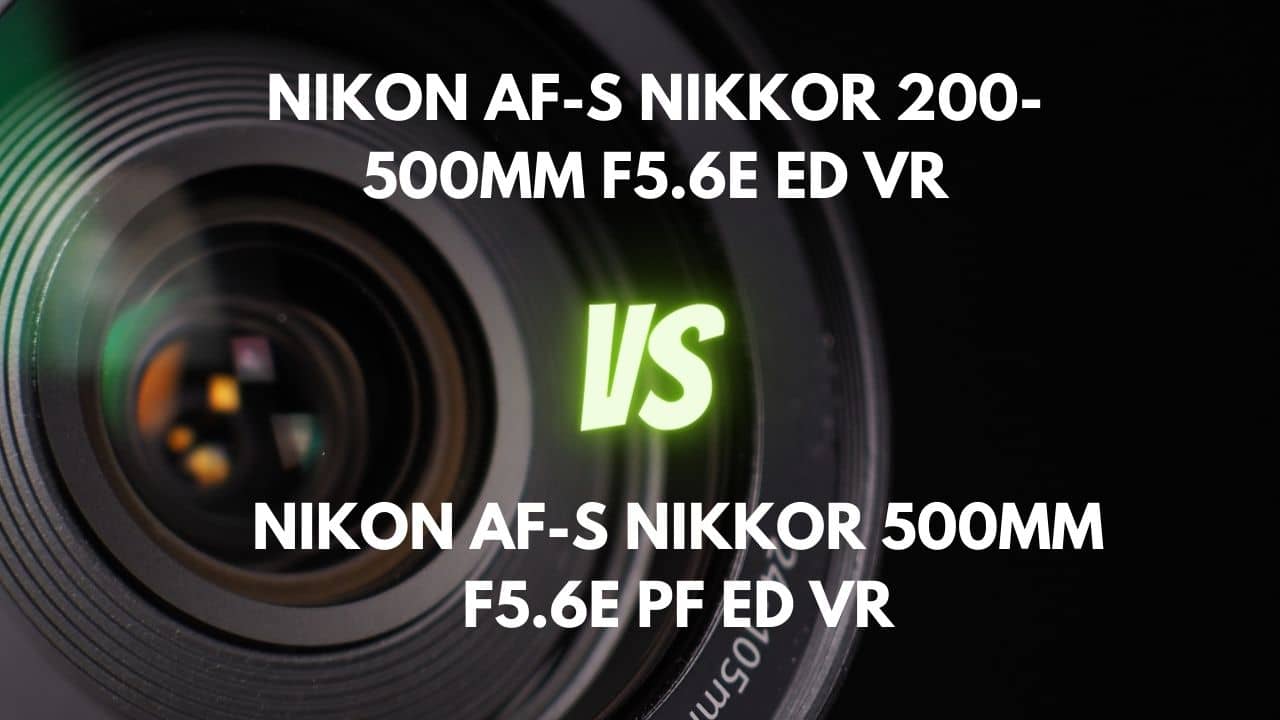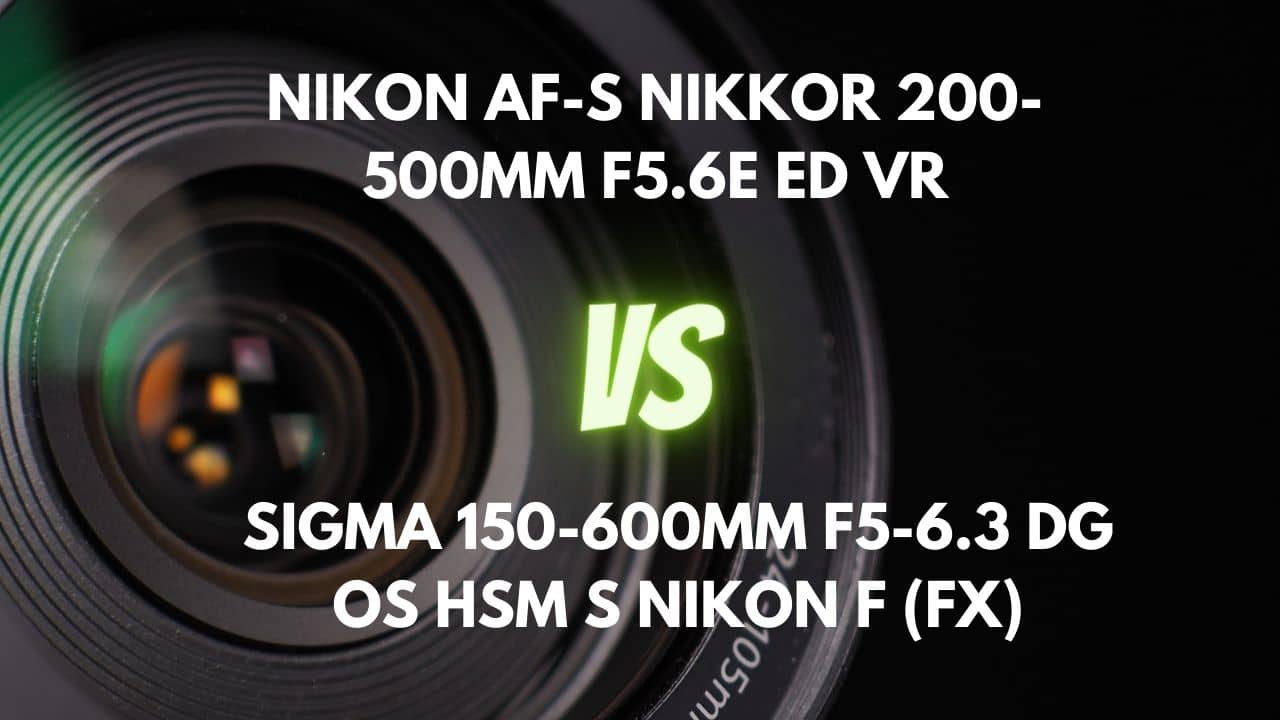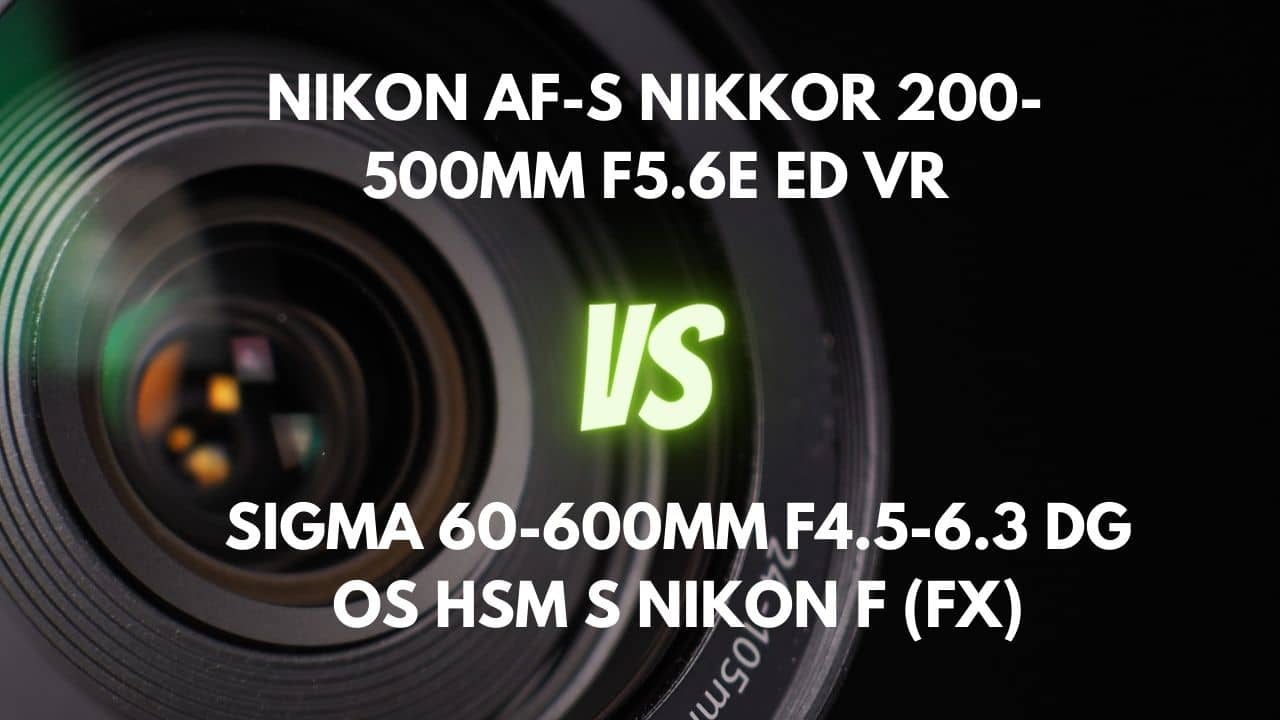Are you a passionate photographer seeking the perfect telephoto lens to capture mesmerizing sports action or awe-inspiring wildlife moments?
If so, we have a captivating comparison between two highly acclaimed lenses: the Nikon 200-500mm f/5.6 and the Tamron 150-600mm f/5-6.3 G2. Delve into this in-depth analysis to discover how these two lenses cater to your specific photography needs, whether you’re an avid sports enthusiast or a dedicated wildlife photographer.
In this comprehensive comparison, we’ll cover essential aspects such as focal range, build quality, weather sealing, tripod collar design, focusing performance, optical stabilization, sharpness, bokeh quality, etc. By the end of this article, you’ll have a clearer understanding of which lens best aligns with your photography goals, empowering you to make an informed decision and elevate your shooting experience to new heights.
Embark on this informative journey with us as we explore the nuances of these two remarkable lenses, and unveil their strengths and weaknesses, ultimately guiding you to the perfect telephoto lens to help you capture those unforgettable moments in sports and wildlife photography.
Overview
| Nikon AF-S NIKKOR 200-500mm F5.6E ED VR | Tamron SP 150-600mm F5-6.3 Di VC USD G2 Nikon F (FX) | |
|---|---|---|
| Max Aperture | F5.6 | F5-6.3 |
| Aperture Type | Fixed | Variable |
| Focal Range (mm) | 200-500 | 150-600 |
| Mount Type | Nikon F (FX) | Nikon F (FX) |
| Zoom Ratio (X) | 2.5 | 4 |
Comparing the Nikon 200-500mm f/5.6 and Tamron 150-600mm f/5-6.3 G2, the Nikon lens has a fixed aperture of f/5.6, while the Tamron lens has a variable aperture of f/5-6.3. Fixed aperture lenses tend to perform better in low light conditions and deliver more consistent image quality across the zoom range.
The Nikon lens has a focal range of 200-500mm, while the Tamron lens has a wider range of 150-600mm. The Tamron lens offers more versatility in terms of composition and framing, making it suitable for a variety of photography genres and situations. However, the Nikon lens, with its 2.5x zoom ratio, may offer better image quality due to its narrower focal range.
Both lenses feature a Nikon F (FX) mount and are compatible with 35mm full-frame cameras. The Tamron lens has a 4.0x zoom ratio, which provides greater flexibility compared to the Nikon lens’s 2.5x zoom ratio.
However, the Tamron lens’s wider focal range and greater zoom ratio might provide more versatility in framing and capturing different subjects at varying distances.
Design and Ease of Use
| Nikon AF-S NIKKOR 200-500mm F5.6E ED VR | Tamron SP 150-600mm F5-6.3 Di VC USD G2 Nikon F (FX) | |
|---|---|---|
| Diameter x Length (mm) | ⌀108×267.5mm | ⌀106×258mm |
| Weight (gr) | 2300 | 1990 |
| Filter Thread (mm) | 95 | 95 |
| Weather Sealing | No | Yes |
| Zoom Method | Rotary (extending) | Rotary (extending) |
| Distance Scale | Yes | Yes |
| DoF Scale | No | No |
| Hood Supplied | Yes | Yes |
| Tripod Collar | Yes | Yes |
Comparing the Nikon 200-500mm f/5.6 and Tamron 150-600mm f/5-6.3 G2 based on their dimensions and weight, the Nikon lens has a diameter of 108mm and a length of 267.5mm, weighing 2300 grams. In contrast, the Tamron lens has a slightly smaller diameter of 106mm and a shorter length of 258mm, with a lighter weight of 1990 grams.
In sports and wildlife photography, the dimensions and weight of a lens play a crucial role in portability, balance, discreetness, storage, and lens swapping. The Tamron lens has an advantage in these aspects due to its smaller size and lighter weight. It is easier to carry around, making it more comfortable for photographers during extended periods of shooting. Moreover, the Tamron lens contributes to a better-balanced camera setup, making it more comfortable to handle.
The discreetness of the Tamron lens is also beneficial for wildlife photography, as it allows photographers to blend in more easily and capture candid shots without drawing too much attention. Additionally, the Tamron lens takes up less space in a camera bag, leaving room for more gear or making the bag lighter and more manageable. Lastly, the lighter weight of the Tamron lens makes it easier to swap lenses quickly in fast-paced environments.
In conclusion, considering the dimensions and weight, the Tamron lens is the superior choice for sports and wildlife photography, providing a more compact and lightweight option that offers better portability, balance, discreetness, and ease of lens swapping.
Lens Mount and Barrel
The lens mount of Nikon 200-500mm f/5.6 is made of metal with a rubber gasket for protection against dust and moisture, while the lens mount of Tamron 150-600mm f/5-6.3 G2 also features a metal construction and a rubber gasket for weather sealing. Both lens mounts provide a sturdy and durable connection between the lens and the camera, with rubber gaskets ensuring protection from the elements.
The lens barrel of the Nikon lens combines metal and high-grade plastic, with a metal outer barrel and a plastic inner barrel. The Tamron lens, on the other hand, has a metal exterior for a durable and premium appearance. Both lenses have textured rubber rings for a comfortable grip and easy adjustment. When zooming in or out, both lenses change their physical size, but they also include a lock switch to prevent barrel creep.
Plastic lens barrels are generally lighter and more budget-friendly, but they may not be as durable as metal ones. Metal lens barrels provide better strength and durability, although they are often heavier. Both Nikon and Tamron lenses combine these materials to strike a balance between weight, durability, and cost.
Considering the build quality and materials used in both lens mounts and barrels, it’s difficult to definitively declare one lens superior to the other. Both lenses offer durable metal mounts with rubber gaskets for protection, and their lens barrels provide a mix of metal and plastic materials for an optimal balance of weight and durability.
Weather Sealing
When it comes to capturing images of sports and wildlife, weather sealing is a crucial aspect that shields camera lenses from dust, moisture, and light water droplets. This safeguards the lenses and guarantees their robustness and effectiveness in different weather conditions. Comparing the Nikon and Tamron lenses based on their weather sealing, we find some significant differences.
The Nikon 200-500mm f/5.6 offers limited weather protection, with a rubber gasket at the lens mount but no internal seals at the rings, switches, or front of the barrel. It also lacks a fluorine coating on the front element. While the Nikon lens can handle some cold, dust, and moisture, it is not designed for heavy abuse or exposure to extreme weather conditions like a pro-level lens.
On the other hand, the Tamron 150-600mm f/5-6.3 G2 boasts robust weather sealing, including a gasket at the lens mount, internal seals at key points, and a protective fluorine compound coating on the front element. This weather sealing, combined with moisture-resistant construction and leak-proof seals throughout the lens barrel, makes the Tamron lens suitable for various outdoor shooting conditions.
Given the importance of weather sealing in sports and wildlife photography, the Tamron lens emerges as the superior choice in this comparison. Its comprehensive weather sealing ensures durability and reliable performance in challenging environments, providing photographers with peace of mind while capturing outdoor action and wildlife scenes.
Rings
Nikon 200-500mm f/5.6 is equipped with dual rings – a ribbed zoom ring and a textured rubber focus ring – that are specifically engineered to provide effortless rotation and a premium tactile experience. The zoom ring takes almost 180 degrees of rotation to zoom from 200mm to 500mm, while the focus ring allows for full-time manual focus override with a focus limiter function. The placement of these rings ensures easy adjustment and a good balance in grip technique. The lens also has a zoom lock switch at its shortest 200mm length and a windowed distance scale.
The Tamron 150-600mm f/5-6.3 G2 also has two rings: a textured rubber focus ring and a larger zoom ring. The zoom ring requires a 135-degree turn to fully zoom from 100mm to 400mm, while the focus ring offers 130 degrees of rotation for precise manual focusing. The lens barrel extends during zooming, and a lock switch is available to secure the lens at the 100mm position.
A windowed distance scale is provided on the lens barrel. The lens design is sleek and modern, with ergonomic bevels and a mostly smooth rotation experience for both rings. However, the focus ring could offer more feedback to improve the manual focusing experience.
In conclusion, both the Nikon and Tamron lenses have well-designed rings that offer good control, precision, and ergonomics. The Nikon lens provides a slightly more comfortable grip, while the Tamron lens has a more modern design and requires less rotation for zoom adjustments.
Switches/Buttons
When comparing the Nikon 200-500mm f/5.6 and Tamron 150-600mm f/5-6.3 G2 based on their switches and buttons, it’s important to consider their functionality, ease of use, and overall design. Both lenses feature a total of 4 main switches that serve similar purposes.
The Nikon lens has an AF/MF switch, focus limiter switch, IS switch, and a VR mode switch. These switches allow for full-time manual focus override, restricting autofocus distance, and controlling the vibration reduction system. The switches are easy to locate and use, with well-designed and textured focus and zoom rings for comfortable handling.
The Tamron lens also has 4 main switches: AF/MF, focus range limiter, VC (Vibration Compensation) on/off, and the VC mode switch. These switches are within easy reach and designed for use even when wearing gloves. However, their light action can make them feel less durable and prone to accidental changes. The Tamron lens also offers additional features, such as a dedicated Lock switch to lock the zoom ring at any focal length and a Flex Zoom Lock for locking the focal length by sliding the zoom ring forward.
In conclusion, while both lenses have comparable switches and buttons for essential functions, the Tamron lens offers additional features that provide extra versatility and control during shooting. Although its switches may feel less durable, the Tamron lens still emerges as the superior choice in terms of switches and buttons due to its added functionality, making it more convenient for photographers to adapt to various shooting scenarios.
Filter Thread
Comparing the Nikon 200-500mm f/5.6 and Tamron 150-600mm f/5-6.3 G2 based on their filter threads, both lenses feature a 95mm filter thread size, which is relatively uncommon and can result in higher filter costs.
The material of the Nikon lens filter thread is typically metal, ensuring durability and a secure fit for filters. The front element and filter thread do not rotate during focusing, making it easy to use with polarizing and graduated neutral density filters. Reputable brands such as B+W and Hoya offer high-grade filters that are compatible with this lens.
On the other hand, the filter ring of Tamron lens doesn’t rotate, making it easy to use with filters, and a reversible lens hood is included. The large Tamron center-and-side-pinch lens cap can be installed and removed with light gloves on. The lens does not have a drop-in filter feature at the rear, which some photographers may prefer to avoid the need for adapter rings.
In conclusion, both the Nikon and Tamron lenses have 95mm filter threads, making them equal in terms of compatibility, availability, and cost. The non-rotating filter threads on both lenses allow for easy use with various filters.
Lens Hood
When comparing the Nikon 200-500mm f/5.6 and Tamron 150-600mm f/5-6.3 G2 based on their lens hoods, both come with a lens hood included in the package.
The Nikon lens hood features a one-piece plastic bayonet design that can be reversed and attached to the lens during transportation. With a 5″ diameter and 4″ length, the hood is large and efficiently prevents flare while maintaining image contrast. The plastic material ensures durability, and the smooth finish allows for easy rotation.
On the other hand, the Tamron lens hood is also made of plastic but has a semi-rigid, ribbed interior, which helps prevent light reflections. The hood measures approximately 5 inches across and 4 inches long. It can be easily installed and removed even with light gloves on, and the center-and-side-pinch lens cap can be used while the hood is in place. Although reversing the hood for storage can be a bit challenging, it is an improvement from the previous version. Despite its deceptive size, the lens hood remains compatible with 95mm filters.
In conclusion, both lens hoods offer adequate protection and flare reduction, with the Nikon lens hood being slightly easier to handle and reverse for storage. The Tamron lens hood’s ribbed interior provides an advantage in preventing light reflections. While the Nikon lens hood might have a more straightforward design, the Tamron lens hood offers a few additional features that some photographers may find appealing.
Tripod Collar
In comparing the Nikon 200-500mm f/5.6 and Tamron 150-600mm f/5-6.3 G2 for sports and wildlife photography, the tripod collar plays a vital role in providing stability and support.
A tripod collar is integrated into the Nikon lens, featuring a single connection point situated towards the rear of the lens barrel. While this design provides stability, a two-point stabilization system – like the ones offered in replacement lens collars from Kirk and RRS – could further enhance the lens’s stability.
Since the tripod collar is not directly compatible with Arca-Swiss, some photographers opt to replace the stock collar with an aftermarket option that provides superior support and compatibility. The collar can be removed for more comfortable handheld use.
In contrast, the Tamron lens boasts a well-designed, functional, and user-friendly tripod collar. It is removable and rotatable, which allows for versatile use on tripods and monopods. The collar also features an Arca-Swiss compatible foot, making it easy to fit into various tripod heads without needing extra attachments or switching the foot.
This compatibility provides added convenience for photographers using the popular Arca-Swiss mounting standard. The collar’s design ensures stability and smoothness, while the thumbscrew allows for easy adjustment. Additionally, the foot has multiple tripod mounts for increased flexibility.
In conclusion, the Tamron lens offers a superior tripod collar design for sports and wildlife photography. Its user-friendly features, Arca-Swiss compatibility, and flexible mounting options provide photographers with a more convenient and stable shooting experience. While the Nikon lens tripod collar is functional, the Tamron lens collar excels in terms of versatility and ease of use, making it the better choice for photographers who value convenience and stability.
Focusing and Optical Stabilization
| Nikon AF-S NIKKOR 200-500mm F5.6E ED VR | Tamron SP 150-600mm F5-6.3 Di VC USD G2 Nikon F (FX) | |
|---|---|---|
| Autofocus | Yes | Yes |
| AF Motor | Silent Wave Motor | Ultrasonic |
| Rotating Front Element | Does not rotate on focusing | Does not rotate on focusing |
| Min Focus Distance | 2.2m | 2.2m |
| Max Magnification (X) | 0.22 | 0.2 |
| Full-Time Manual Focus | Yes | Yes |
Focusing Performance
Incorporated into the Nikon 200-500mm f/5.6 is a Silent Wave Motor (SWM), which guarantees noiseless autofocus performance and permits manual focus override at any time when set to the M/A position. Its autofocus speed is quite good, even faster than many f/1.8 Nikon primes. The lens is also strong in terms of accuracy and consistency, with excellent repeatability.
The manual focus action is smooth, with a wide focus ring for precise adjustments. Furthermore, due to its internal focusing design, the length of the Nikon lens remains unchanged, and the front element does not rotate during focusing. This makes it an ideal choice for use with polarizing filters, as it simplifies filter adjustment and ensures consistent image quality.
On the other hand, the Tamron 150-600mm f/5-6.3 G2 utilizes an Ultrasonic Silent Drive (USD) ring-type motor for quiet and efficient focusing. While its focusing speed is generally fast, it slows down at longer focal lengths, such as 600mm, and may struggle in low-light situations. The lens can focus accurately in most cases, but may occasionally have difficulties when subjects change position rapidly or in challenging lighting conditions. The G2 version offers full-time manual focus override, allowing for fine-tuning when necessary.
The manual focus ring is smooth and well-dampened. Although the lens does not feature an internally focusing design, the front element does not rotate during focusing. Focus breathing may be present but is generally not a significant concern for most users.
In conclusion, the Nikon lens offers superior focusing performance for sports and wildlife photography. Its faster and more consistent autofocus, combined with its smooth manual focus action and internally focusing design, make it a better choice for capturing fast-moving subjects and working in challenging conditions. The Tamron lens is still a strong contender, but the Nikon lens edges it out in terms of overall focusing performance.
Optical Stabilization
In the realm of sports and wildlife photography, optical stabilization plays a crucial role in capturing sharp images. Comparing the Nikon and Tamron lenses, both offer effective stabilization systems, but there are some differences worth noting.
The Nikon 200-500mm f/5.6 features a Vibration Reduction (VR) system that provides up to 4.5 stops of stabilization, enabling sharp images even at slower shutter speeds. This system operates silently, making it ideal for both photography and video recording. The lens provides two stabilization modes – Normal and Sport – each with unique settings optimized for different shooting scenarios. Sport mode is specifically tailored to track fast-moving subjects with accuracy and precision. When shooting at 500mm with VR on, usable shots can be achieved at shutter speeds as slow as 1/60 seconds, and in some cases, even down to 1/25 seconds.
The Tamron 150-600mm f/5-6.3 G2, on the other hand, features Tamron’s Vibration Compensation (VC) system, which offers up to 4.5 stops of stabilization in Mode 3. This lens has three VC modes: standard, panning, and one that prioritizes stabilization during capture but doesn’t stabilize the image through the viewfinder. The VC system is very quiet, producing only a faint hum and some light clicking when active. Shutter speeds and stabilization performance vary depending on the focal length and the user’s handholding technique. In Mode 3, the success rate improves, with over 80% success down to 1/30 sec at 600mm, 60% at 1/15 sec, and 20% at 1/8 sec.
In conclusion, the Nikon lens offers superior optical stabilization due to its consistent performance across various shooting situations, making it more suitable for sports and wildlife photography. While the Tamron lens provides a competitive stabilization system with different modes, the Nikon lens’s ability to maintain sharpness at slower shutter speeds gives it an edge in this comparison.
Image Quality
| Nikon AF-S NIKKOR 200-500mm F5.6E ED VR | Tamron SP 150-600mm F5-6.3 Di VC USD G2 Nikon F (FX) | |
|---|---|---|
| Special Elements | 3 ED elements | eBAND (Extended Bandwidth & Angular Dependency) Coating; Fluorine Coating |
| Diaphragm Blades | 9 | 9 |
| Circular Aperture | Yes | Yes |
Aberration
The Nikon 200-500mm f/5.6 demonstrates minimal chromatic aberration, even in areas with high contrast, making it difficult to find color fringing even at a 200% crop. Chromatic aberration levels are low at 200mm and 300mm, increasing slightly at 400mm and 500mm focal lengths.
The lens does exhibit some cat’s-eye effect towards the borders/corners of the sensor, and there is noticeable coma towards the corners. Although the bokeh of the lens exhibits a minor “onion-ring” effect, the inclusion of extra-low dispersion lens elements significantly reduces spherical aberration, which in turn enhances the overall sharpness and contrast of the lens.
On the other hand, the Tamron 150-600mm f/5-6.3 G2 handles chromatic aberration quite well, with axial (longitudinal, bokeh) chromatic aberration being well corrected. Lateral chromatic aberration, however, is more pronounced, particularly at longer focal lengths, but can be easily corrected via software.
Coma is not specifically addressed, but the lens does exhibit some issues with spherical aberration and spherochromatism, especially at the widest apertures. Stopping down one to two stops can generally remove this aberration.
In conclusion, both lenses show impressive aberration control, but the Nikon lens has a slight advantage due to its minimal chromatic aberration and effective control of spherical aberration through the use of extra-low dispersion lens elements. The Tamron lens performs well in controlling chromatic aberration, but may require stopping down to address issues with spherical aberration and spherochromatism for optimal image quality.
Sharpness
Across the entire zoom range, the Nikon 200-500mm f/5.6 exhibits exceptional center sharpness, but some softness is noticeable in the corners at longer focal lengths and wider apertures. However, stopping down to around f/11 improves corner sharpness significantly.
At 200mm, the lens delivers very good center sharpness at f/5.6, improving to excellent levels at f/8. Sharpness tends to decrease as you zoom in, with a noticeable drop at 500mm, although it remains usable. Using a teleconverter can negatively impact autofocus accuracy and potentially reduce the sharpness of the lens even further.
The Tamron 150-600mm f/5-6.3 G2 exhibits good center sharpness at a wide open aperture throughout the focal length range, with sharpness slightly tapering off from 500mm to 600mm. Stopping down to f/8 enhances sharpness, particularly in focal lengths wider than 500mm.
The mid and periphery portions of the image circle display modest softness at 150mm and 200mm with a wide open aperture, while corners become reasonably sharp at 300mm and 400mm. Stopping down to f/8 or f/11 doesn’t yield significant improvement in sharpness at 500mm and 600mm. At 600mm f/6.3, corner sharpness dramatically declines, but center sharpness improves when the lens is stopped down.
The lens’ sweet spot for sharpness lies between 200mm and 450mm. When using a teleconverter, it’s crucial to calibrate focus for optimal sharpness. The sharpest aperture for this lens varies depending on the focal length, but it’s generally around f/8.
In conclusion, both lenses demonstrate commendable sharpness performance, but the Nikon lens has a slight advantage due to its consistent center sharpness throughout the zoom range and improved corner sharpness when stopped down. The Tamron lens offers good sharpness, with its sweet spot lying between 200mm and 450mm, and may require stopping down for optimal performance at longer focal lengths.
Bokeh Quality
In sports and wildlife photography, bokeh quality plays an essential role in isolating subjects from the background and creating aesthetically pleasing images. Comparing the Nikon and Tamron telephoto lenses, we can see differences in their bokeh performance.
The Nikon 200-500mm f/5.6 delivers pleasing bokeh with smooth and beautiful out-of-focus areas. The lens has an iris diaphragm with 9 rounded aperture blades, contributing to an attractive rendition of out-of-focus areas. It effectively handles specular highlights and background isolation, resulting in appealing bokeh without any onion-shaped highlights or distracting patterns. The bokeh balls in the Nikon lens demonstrate minimal longitudinal chromatic aberration, and while some cat’s-eye effect is noticeable, it is not overly intrusive.
Conversely, the Tamron 150-600mm f/5-6.3 G2 produces a generally satisfying bokeh, with smooth out-of-focus areas that are aesthetically pleasing in many situations. However, it can occasionally display slight donut edges with small specular highlights in the background, while foreground highlights tend to have more uniform edges. The bokeh quality is noticeably softer when compared to its predecessor. Although the bokeh may exhibit a bit of busyness at certain distances, it typically appears quite lovely.
In conclusion, both lenses offer pleasing bokeh quality for sports and wildlife photography, but the Nikon lens has a slight edge due to its smoother out-of-focus areas, better handling of specular highlights, and less intrusive cat’s-eye effect. The Tamron lens still provides an attractive bokeh in most situations, though it may exhibit some busyness and donut edges on occasion.
Flare/Ghosting
Flare and ghosting can impact image quality, especially when strong light sources are present in or near the frame.
The Nikon 200-500mm f/5.6 displays good flare-resistance, but in instances where a strong light source is located directly in the frame or near the edge of the image, ghosting and flare can still occur. As long as the light is clearly outside the image-frame, the lens does not produce any artifacts. The flare patterns generated by this lens are uncomplicated and devoid of additional coloration. It is important to be cautious of strong light sources just outside the frame, but overall, the lens demonstrates good performance in terms of ghosting and flare control.
In contrast, the Tamron 150-600mm f/5-6.3 G2 exhibits average flare performance, particularly considering the high number of lens elements. Flare effects can be observed when the sun is positioned in the corner of the frame, especially at telephoto focal lengths. The lens incorporates anti-reflection technologies such as eBAND and BBAR coatings, which help suppress internal reflections and reduce ghosting and flare when shooting backlit subjects. Despite these coatings, shooting without the lens hood may still result in some ghosting and flare. It is important to note that flare and ghosting performance may vary depending on the focal length and aperture used.
In conclusion, while both lenses have their own flare and ghosting characteristics, the Nikon lens demonstrates a slightly superior performance with its good flare-resistance and simpler flare patterns. The Tamron lens, though equipped with anti-reflection technologies, exhibits average flare performance and requires more careful handling of light sources.
Vignetting
Vignetting, the gradual darkening of an image’s edges, can affect image quality and may be more noticeable at specific focal lengths.
Impressive control over vignetting is demonstrated by the Nikon 200-500mm f/5.6, with only slight darkening of the edges noticeable at focal lengths beyond 300mm when focused at infinity. At shorter focal lengths, vignetting is essentially non-existent. While some vignetting may be present, it can be effortlessly corrected in post-processing, and it can even add a delightful quality to the images.
On the other hand, the Tamron 150-600mm f/5-6.3 G2 exhibits mild vignetting, more noticeable on full-frame sensors, particularly at 150mm and 600mm focal lengths. Stopping down to f/8 or smaller can help reduce the vignetting, but it may not be completely eliminated. On APS-C sensors, vignetting is less prominent, and stopping down the aperture can virtually eliminate it. The extent of vignetting may not be problematic for most shooting situations, as it is relatively minor and can be corrected in post-processing if needed.
In conclusion, the Nikon lens demonstrates superior control over vignetting, with minimal darkening at longer focal lengths and virtually no vignetting at shorter focal lengths. While the Tamron lens exhibits mild vignetting at certain focal lengths, it can still be managed through aperture adjustments and post-processing.
Distortion
Distortion in camera lenses can affect image quality, and understanding how each lens handles this issue can help inform your decision.
The Nikon 200-500mm f/5.6 displays some pincushion distortion across various settings and distances, but it is typically imperceptible in real-world situations. Most Nikon DSLRs can automatically correct this distortion, and if necessary, it can be effortlessly removed using post-processing tools. Despite these minor flaws, the lens produces sharp images with minimal linear distortion. In conclusion, distortion is generally manageable and can be corrected without much difficulty using either in-camera or post-processing correction methods.
In contrast, the Tamron 150-600mm f/5-6.3 G2 exhibits a slight pincushion distortion at the 150mm focal length, which becomes less noticeable at 300mm and slightly more visible at 400mm. As you zoom in further, the distortion remains relatively controlled but may become more apparent at the longest focal lengths. Keep in mind that distortion can also be corrected through post-processing software if needed.
In conclusion, both lenses exhibit some level of pincushion distortion, but the Nikon lens offers a more consistent performance across various settings and distances. Although the Tamron lens demonstrates relatively controlled distortion, it may become more apparent at certain focal lengths.
Final Verdict
Taking all factors into account, the Tamron 150-600mm f/5-6.3 G2 emerges as the superior choice for sports and wildlife photography. While the Nikon 200-500mm f/5.6 has some advantages in terms of bokeh quality, vignetting, and distortion control, the Tamron lens offers a wider focal range, better portability, comprehensive weather sealing, a more versatile tripod collar, and competitive image quality.
The Tamron’s wider focal range, from 150mm to 600mm, provides more versatility in framing and composition, allowing photographers to adapt to various situations. Its compact and lightweight design ensures better portability and ease of lens swapping, making it an ideal choice for photographers on the move.
Moreover, the Tamron lens’s comprehensive weather sealing ensures durability and reliable performance in challenging environments, which is essential for outdoor sports and wildlife photography. Its superior tripod collar design adds to its appeal, providing user-friendly features and versatile mounting options.
While the Nikon lens does excel in certain aspects, such as focusing performance, optical stabilization, and aberration control, the Tamron lens offers a more well-rounded package for sports and wildlife photography. Thus, the Tamron lens is the recommended choice for photographers seeking a versatile, portable, and durable telephoto lens for capturing stunning sports and wildlife images.

